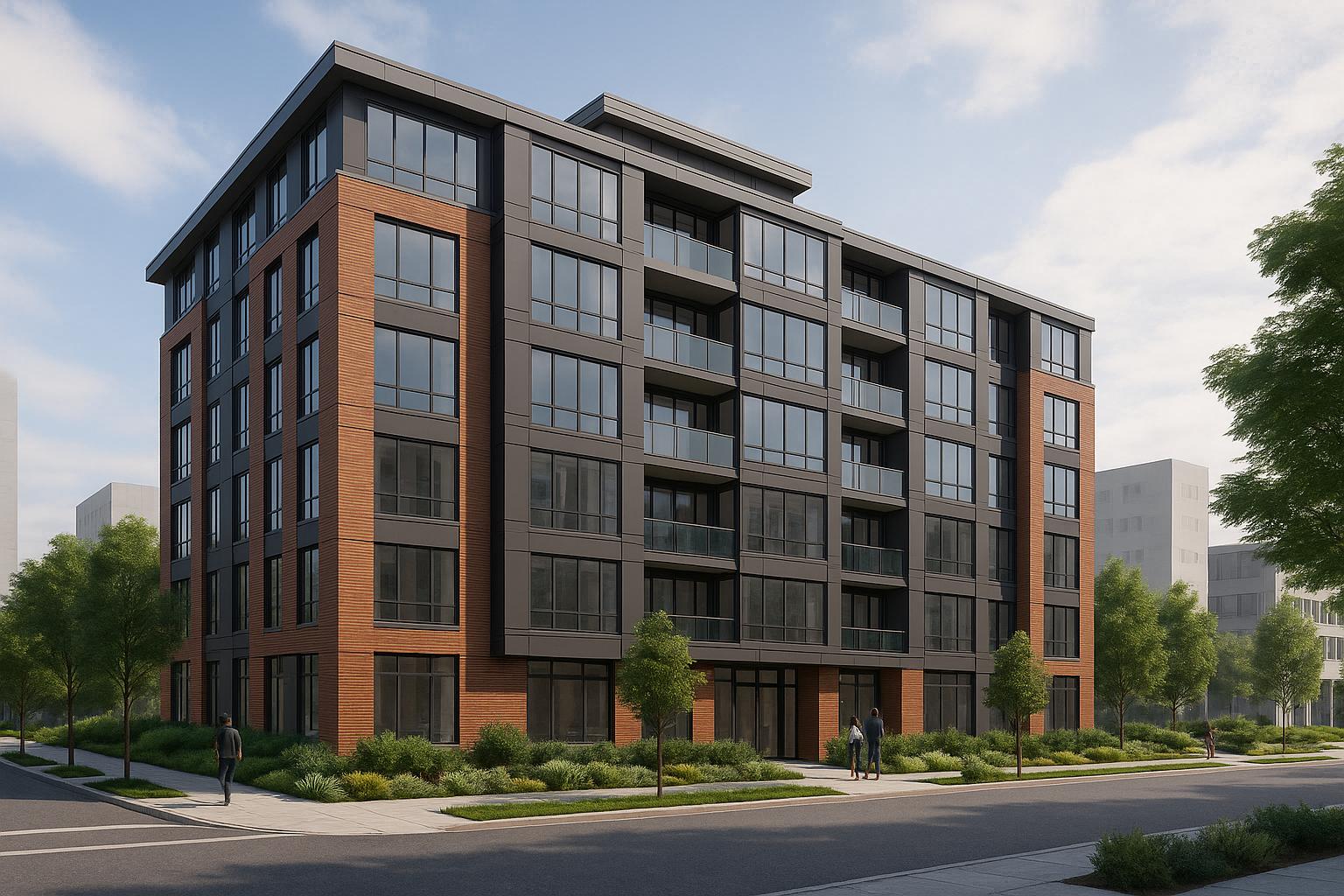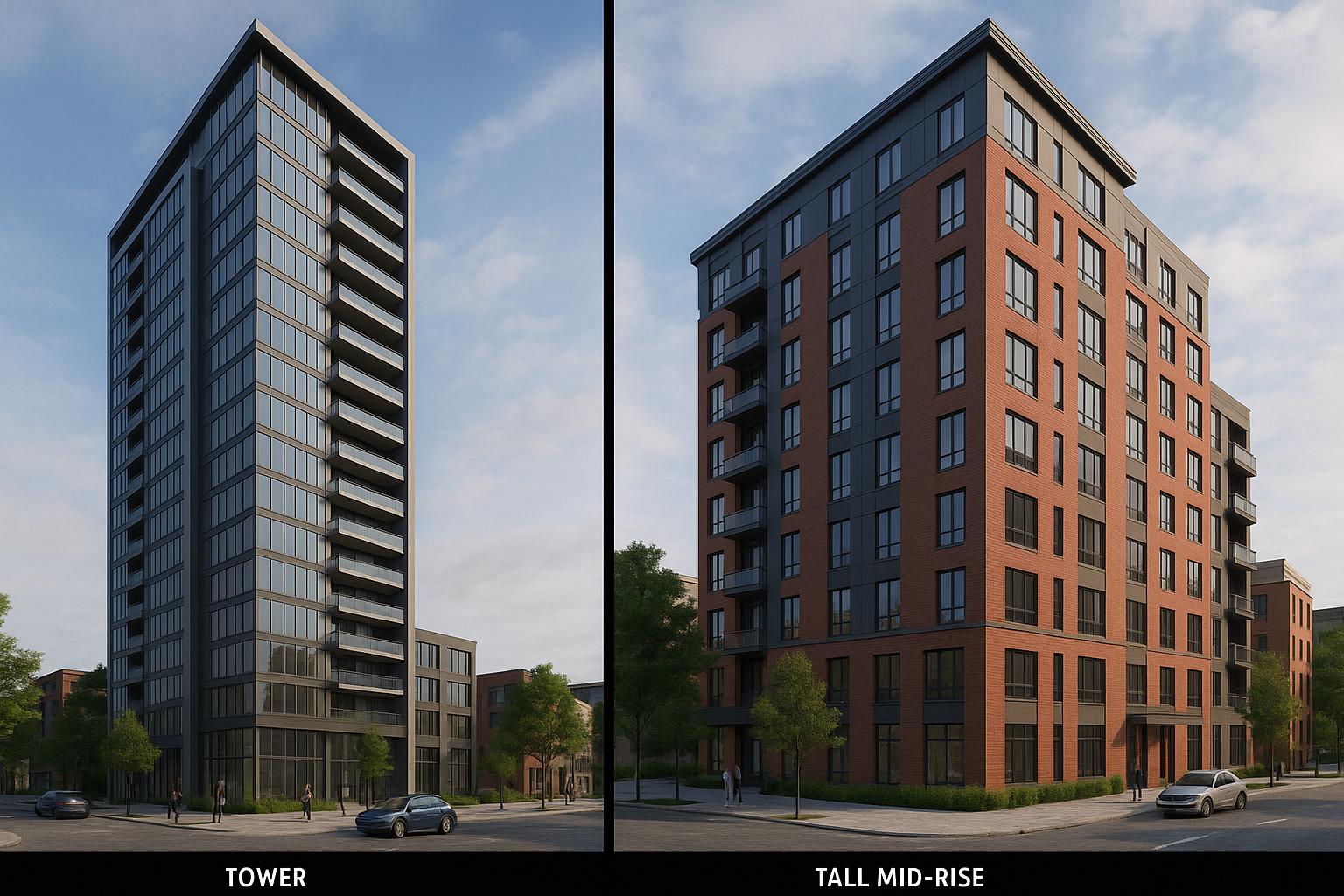Yes, ER-3 and ER3 are the same zoning designation in Halifax. The difference is purely the hyphen, and both refer to "Established Residential - 3." This zoning allows up to 8 residential units per lot, including duplexes, townhomes, and small apartment buildings, with a 12-metre height limit (approximately three storeys). Lot size determines building coverage: 50% for lots over 3,500 ft² and 60% for smaller lots.
Recent updates under the Housing Accelerator Fund have simplified approvals, reduced parking requirements, and streamlined permitting. These changes support Halifax’s plan to add over 15,000 units by 2026 to address housing demand driven by rapid population growth. If you're considering development, consult Halifax’s zoning documents, real estate experts, and design-build firms to ensure compliance and efficiency.
How to Quickly Look Up Zoning in Halifax, Nova Scotia
What ER-3 Zoning Allows: Buildings and Uses
ER-3 zoning in Halifax opens the door to multi-unit housing developments, offering opportunities for property owners to maximize the use of their land.
Buildings and Uses Allowed Under ER-3
With ER-3 zoning, property owners can develop up to eight residential units on a single lot. This includes a variety of housing types such as duplexes, townhomes, small apartment buildings, and condominiums.
"It would allow up to eight units of duplexes, townhomes, small apartments or condos to be built on a single lot." - Haley Ryan, Reporter, CBC News [2]
Buildings in ER-3 zones are subject to a 12-metre height limit, which is approximately three storeys. Lot size also plays a role in determining building coverage:
- Lots over 3,500 ft²: Buildings may cover up to 50% of the lot.
- Lots under 3,500 ft²: Buildings may cover up to 60% of the lot [1].
This zoning category is designed to encourage "missing middle housing." These are medium-sized residential options that fill the gap between single-family homes and large high-rise developments.
Halifax Areas with ER-3 Zoning
Specific neighbourhoods across the Halifax Regional Municipality (HRM) are designated as ER-3 zones. To confirm your property’s zoning, you can use Halifax’s online mapping tool.
ER-3 zoning is part of Halifax’s broader Suburban Housing Accelerator Plan, which aims to add 15,467 new residential units by 2026 [3]. Halifax’s population has been growing rapidly, reaching 492,200 residents in 2023, with an increase of over 19,000 people (4%) in just one year [3]. However, properties located within designated heritage zones have stricter development rules [3].
These neighbourhood-specific designations have paved the way for recent updates to ER-3 zoning regulations.
Recent Changes to ER-3 Zoning Rules
Recent updates to ER-3 zoning were introduced under the Housing Accelerator Fund initiative, supported by $79.3 million in federal funding. These changes represent a major shift in how multi-unit developments are approved and managed [3].
Key updates include:
- By-right construction permissions: Simplified approvals for certain developments.
- Reduced parking requirements: Especially in areas with good transit access.
- Streamlined permitting processes: Less red tape to navigate.
These changes are already influencing property values, as the potential for multi-unit development increases land desirability. The rental market is also reflecting this trend, with two-bedroom units in Halifax renting for $1,950 to $2,100 per month [3].
How ER-3 Zoning Affects Multi-Unit Construction
For property owners eyeing rental developments in Halifax, ER-3 zoning offers a way to increase density, making it easier to build small-scale multi-unit rental projects. This zoning not only allows for higher density but also comes with specific design standards tailored to multi-unit developments.
Multi-Unit Projects Under ER-3 Zoning
For lots smaller than 3,200 square feet, ER-3 zoning permits up to three units with the option to add one additional suite. However, these projects must adhere to a 60% lot coverage limit. If the design includes a 3-metre habitable attic, it’s possible to construct up to four storeys. That said, compact designs may face challenges with stair and egress requirements, which need careful planning. Beyond these technical details, ER-3 zoning plays a role in supporting broader housing strategies for the community.
ER-3 and Missing Middle Housing
ER-3 zoning addresses the "missing middle" housing gap by allowing moderate density increases in established neighbourhoods. It creates a bridge between single-family homes and larger apartment buildings, offering housing options that are both diverse and appropriately scaled. By aligning designs with lot characteristics and zoning rules, property owners can use ER-3 zoning to contribute to balanced community development.
sbb-itb-16b8a48
ER-3 Zoning Problems and How to Solve Them
ER-3 zoning can open up exciting opportunities for property development, but it often comes with a set of challenges that can complicate the process. From navigating intricate regulations to managing multi-disciplinary teams, these hurdles can lead to delays and increased costs if not handled properly.
Common ER-3 Zoning Mistakes
One frequent misstep is misjudging the complexity of ER-3 zoning requirements. Many property owners mistakenly believe that ER-3 zoning automatically allows their desired number of units, without fully understanding the specific restrictions on buildings, structures, and land use. This oversight can lead to costly design revisions and compliance headaches down the line.
Disjointed project teams are another major issue. When architects, engineers, and contractors fail to coordinate effectively, last-minute design changes become inevitable. These changes can inflate costs by 30–60% and stretch timelines from the expected 8 months to 18 months or more. Worse, non-compliance with zoning regulations can result in fines, forced modifications, or even permit revocation [6].
Integrated Design-Build vs Traditional Construction Methods
Traditional construction methods often rely on separate contracts for architects, engineers, contractors, and other specialists. This fragmented structure can lead to miscommunication and inconsistent interpretations of ER-3 zoning requirements, making it harder to achieve compliance.
An integrated design-build approach offers a more streamlined solution. By combining planning and construction under a single contract, this method ensures that zoning compliance is addressed early in the process. Teams work together from the start, reducing delays and minimizing disputes. The integrated approach also makes it easier to adapt to evolving interpretations of zoning rules, thanks to its flexibility and unified accountability. Early expert involvement further smooths the process, helping to avoid costly setbacks [4][5].
How to Navigate ER-3 Zoning Successfully
Understanding the specifics of ER-3 zoning is crucial, and early consultation can turn that understanding into actionable steps. Reaching out to Halifax planning authorities and legal experts early in the process can clarify zoning constraints and simplify rezoning or variance applications.
A knowledgeable real estate attorney can guide property owners through local land use laws, explain their rights, and assist with rezoning or variance applications if their plans don’t perfectly align with ER-3 restrictions. These processes often involve public hearings, which can introduce delays, so factoring in extra time is essential [6].
Partnering with experienced design-build firms can further reduce risks. Firms that specialize in multi-unit construction under Halifax’s zoning regulations bring valuable expertise and coordination to the table, helping to identify and resolve potential compliance issues early. A well-planned approach not only avoids unnecessary complications but also safeguards your investment.
Key Points About Building Under ER-3 Zoning
ER-3 zoning in Halifax presents a compelling opportunity for property owners to develop multi-unit rental properties that can generate solid returns. By understanding the advantages and carefully navigating the process, property owners can avoid costly missteps and maximize their investments.
Why ER-3 Zoning Works for Property Owners
With ER-3 zoning, property owners can construct buildings up to 12 metres tall (approximately 4 storeys) and include as many as 8 units. This zoning is perfect for addressing the "missing middle" housing demand while offering property owners the potential for 12-20% annual ROI on rental properties - provided the project is well-executed and adheres to lot coverage limits and other zoning rules [1].
ER-3 zoning also opens the door to appealing financing options. Properties designed to meet CMHC MLI Select standards can qualify for 95% financing with just 5% down and benefit from 50-year amortization periods, which significantly enhances cash flow.
These favourable conditions create a strong foundation for making informed and profitable development decisions.
Steps to Take for a Successful Development
To make the most of these zoning benefits, property owners need to take proactive steps to ensure their project runs smoothly and complies with all regulations:
- Obtain a zoning compliance report from Halifax. This report provides detailed information about the specific regulations and restrictions that apply to your property, helping you avoid unexpected issues down the road [7].
- Consult a real estate lawyer to review your building plans and confirm they align with local zoning laws. Zoning regulations can vary significantly, and professional legal advice is crucial to avoid penalties like fines, permit revocations, or even demolition orders [7].
- Work with an integrated design-build firm such as Helio Urban Development. These firms specialize in multi-unit projects under Halifax’s zoning rules, eliminating the inefficiencies of juggling multiple contractors. With fixed-price construction at $160,000 per unit and a 6-month completion guarantee, this approach minimizes the risk of budget overruns and delays, which can otherwise inflate costs by 30-60% and stretch timelines from 8 months to over 18 months.
Additionally, property owners must carefully account for regulatory requirements that impact both construction costs and rental income. Early collaboration with experienced professionals ensures these factors are addressed, setting the stage for a successful and profitable project [1].
FAQs
How does ER-3 zoning help tackle Halifax's housing shortage?
ER-3 zoning is an important tool in tackling Halifax's housing shortage. It permits the construction of up to eight units per lot, promoting denser housing projects. This approach maximizes land use and addresses the city’s housing deficit, which is nearing 20,000 units.
By enabling multi-unit developments, generally ranging from 4 to 24 units, ER-3 zoning helps lower the cost per unit, accelerates the availability of housing, and increases rental options. This zoning model plays a key role in meeting Halifax's rising need for affordable and accessible housing.
What are the advantages of using a design-build approach for ER-3 zoned properties in Halifax?
Using a design-build approach for ER-3 zoned properties in Halifax simplifies the construction journey by merging the design and construction phases into one seamless process. This method provides predictable costs and quicker project timelines, reducing the chances of delays or surprise expenses.
Additionally, it ensures that designs meet energy efficiency standards and align with Halifax's zoning objectives, resulting in developments that blend naturally with the neighbourhood's aesthetic. By streamlining the process, property owners can more easily handle the complexities of zoning regulations while achieving their desired project goals.
How can property owners comply with ER-3 zoning rules in Halifax?
To navigate ER-3 zoning rules in Halifax, the first step is to verify your property’s zoning classification. Halifax offers online mapping tools that make this process straightforward. Once confirmed, ensure your development plans align with ER-3 requirements. Key factors to consider include lot size, maximum lot coverage (40–60%), and building height limits (up to 12 metres or 4 storeys).
If your plans require adjustments or special approvals, you’ll need to submit a development application. This submission should include detailed plans and clear justifications for your project. Be prepared for potential reviews and public hearings as part of the process. For multi-unit dwellings, ensure your design adheres to the zoning’s permitted uses, such as buildings accommodating up to 8 units.
For a smoother experience, consider consulting a professional familiar with Halifax zoning regulations. Their expertise can help you navigate the rules efficiently and avoid unnecessary delays.



